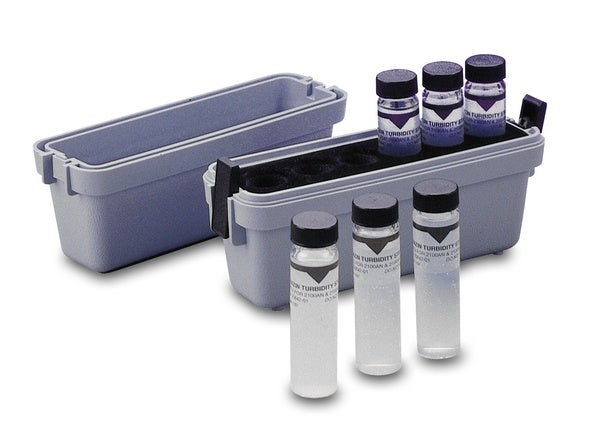Loading... 33 view(s)
Turbidity meters are used to quickly measure the turbidity (or cloudiness) of water, caused by suspended solid particles.
Understanding how turbidity meters work can help in achieving more accurate results and ensuring the samples and meter are handled correctly.
[caption id="attachment_8711" align="aligncenter" width="443"] Turbidity standards, used in calibrating turbidity meters[/caption]
Turbidity standards, used in calibrating turbidity meters[/caption]
 However, this scattering does vary slightly with the size of the particles - large particles may be more prone to scatter light at smaller angles, while small particles will allow light to scatter at larger angles;
However, this scattering does vary slightly with the size of the particles - large particles may be more prone to scatter light at smaller angles, while small particles will allow light to scatter at larger angles;
 This is why some meters state "ratio" and "non-ratio" in their specifications - they use a range of detectors to compensate for differences in the particle sizes present.
When a turbidity meter is measuring with "ratio on" it will use data from several detectors and take an average, in order to correct for changes caused by this particle size difference. For example the Hach TL23 series of turbidity meters can be used with Ratio on or off.
The newest meters from Hach, the TU5 series, take this one step further with their 360° x 90° technology - which measures light in a full 360° circle around the sample, for maximum correction of errors;
[embed]https://youtu.be/-Emt9SSBkoM?list=PLL5AjVHeGuHm4_cih1-H_CojnAmJve92W[/embed]
For more information on turbidity meters, follow the links above, see our previous blog posts on this topic here, or contact us with the form below if you have any questions;
This is why some meters state "ratio" and "non-ratio" in their specifications - they use a range of detectors to compensate for differences in the particle sizes present.
When a turbidity meter is measuring with "ratio on" it will use data from several detectors and take an average, in order to correct for changes caused by this particle size difference. For example the Hach TL23 series of turbidity meters can be used with Ratio on or off.
The newest meters from Hach, the TU5 series, take this one step further with their 360° x 90° technology - which measures light in a full 360° circle around the sample, for maximum correction of errors;
[embed]https://youtu.be/-Emt9SSBkoM?list=PLL5AjVHeGuHm4_cih1-H_CojnAmJve92W[/embed]
For more information on turbidity meters, follow the links above, see our previous blog posts on this topic here, or contact us with the form below if you have any questions;
 Turbidity standards, used in calibrating turbidity meters[/caption]
Turbidity standards, used in calibrating turbidity meters[/caption]
What is Turbidity?
Turbidity is the cloudy or opaque appearance of water caused by suspended solid particles. It is often used as a general water quality indicator, particularly for clean water such as drinking water. See our previous post here for more information on this.How do turbidity meters work?
Electronic turbidity meters work by measuring the amount of light which is scattered at 90° by the suspended particles, as pictured below; However, this scattering does vary slightly with the size of the particles - large particles may be more prone to scatter light at smaller angles, while small particles will allow light to scatter at larger angles;
However, this scattering does vary slightly with the size of the particles - large particles may be more prone to scatter light at smaller angles, while small particles will allow light to scatter at larger angles;
 This is why some meters state "ratio" and "non-ratio" in their specifications - they use a range of detectors to compensate for differences in the particle sizes present.
When a turbidity meter is measuring with "ratio on" it will use data from several detectors and take an average, in order to correct for changes caused by this particle size difference. For example the Hach TL23 series of turbidity meters can be used with Ratio on or off.
The newest meters from Hach, the TU5 series, take this one step further with their 360° x 90° technology - which measures light in a full 360° circle around the sample, for maximum correction of errors;
[embed]https://youtu.be/-Emt9SSBkoM?list=PLL5AjVHeGuHm4_cih1-H_CojnAmJve92W[/embed]
For more information on turbidity meters, follow the links above, see our previous blog posts on this topic here, or contact us with the form below if you have any questions;
This is why some meters state "ratio" and "non-ratio" in their specifications - they use a range of detectors to compensate for differences in the particle sizes present.
When a turbidity meter is measuring with "ratio on" it will use data from several detectors and take an average, in order to correct for changes caused by this particle size difference. For example the Hach TL23 series of turbidity meters can be used with Ratio on or off.
The newest meters from Hach, the TU5 series, take this one step further with their 360° x 90° technology - which measures light in a full 360° circle around the sample, for maximum correction of errors;
[embed]https://youtu.be/-Emt9SSBkoM?list=PLL5AjVHeGuHm4_cih1-H_CojnAmJve92W[/embed]
For more information on turbidity meters, follow the links above, see our previous blog posts on this topic here, or contact us with the form below if you have any questions;






